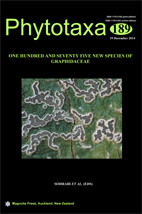Abstract
We provide an updated skeleton phylogeny of the lichenized family Graphidaceae (excluding subfamily Gomphilloideae), based on three loci (mtSSU, nuLSU, RPB2), to elucidate the position of four new genera, Aggregatorygma, Borinquenotrema, Corticorygma, and Paratopeliopsis, as well as the placement of the enigmatic species Diorygma erythrellum, Fissurina monilifera, and Redingeria desseiniana. Based on the resulting topology, in addition to three tribes described previously, we recognize four further tribes in the subfamily Graphidoideae: Acanthothecieae Lumbsch, Kraichak & Lücking, Diploschisteae (Zahlbr.) Lumbsch, Kraichak & Lücking, Leptotremateae Lumbsch, Kraichak & Lücking, and Wirthiotremateae Lumbsch, Kraichak & Lücking. The phylogenetic position of Aggregatorygma and Borinquenotrema was not resolved with support, whereas Corticorygma forms part of Acanthothecieae, supported sister to Acanthothecis, and Paratopeliopsis belongs in Thelotremateae, unsupported sister to Leucodecton. Diorygma erythrellum is confirmed as a member of the Diorygma-Thalloloma clade, while Fissurina monilifera, inspite of its myriotremoid ascomata, belongs in Fissurina s.str. Redingeria dessiniana, although resembling the genus Phaeographopsis, is supported sister to R. glaucoglyphica. Topeliopsis darlingtonii forms the sister group to Gintarasia megalophthalma. Consequently, T. darlingtonii and the closely related T. elixii are recombined in Gintarasia as Gintarasia darlingtonii (Frisch & Kalb) Lumbsch, Kraichak & Lücking, and G. elixii (Frisch & Kalb) Lumbsch, Kraichak & Lücking.

